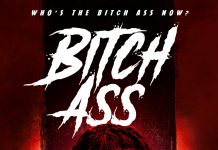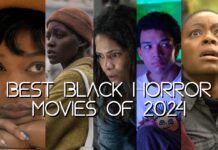Remember all those slasher movies back in the ’80s that featured a black “final girl” vanquishing the unstoppable psychopathic killer during the nail-biting, climactic finale? Me neither. Lucky for us, Black Holler is here to re-envision that era with a modern parody/homage that is single-handedly more inclusive than the entire actual decade of slasher offerings.
Set in 1989, Black Holler revolves around LaQuita Johnson (Tamiko Robinson Steele), a skateboarding badass with a reputation as a “rabble rouser” who’s starting school at O’Fish Community College just as her “Archepology 101” class takes its annual field trip to Black Holler, a wooded area that’s the stuff of local legend. The land is rumored to house a rock with a Native American spell on it that gives its owner “control over all the land and its inhabitants,” and if you think this won’t come into play during the campout, then you clearly haven’t wasted enough of your life watching horror movies.
Exactly how the magic rock comes into play is a bit confounding, though. It seems like there’s one artifact, and then a student finds another artifact, but it’s the same artifact, and although it has powers, the student has to perform a ritual to awaken some mystical force in the woods which may or may not possess someone who starts killing all the kids, but then the forest itself starts killing other people, and then there’s some other ritual that requires a certain number of sacrifices to obtain some goal I’m not quite clear on, plus there’s an underwater zombie for some reason.
Plot-wise, Black Holler is messy and thin — just an excuse to kill people off — but that’s in line with the ’80s slashers it’s parodying. It’s even cheaper than the bulk of those shoestring movies, so casual viewers might be turned off by the low production value — muffled sound, uneven acting, continuity issues — but Black Holler is nothing if not self-aware. It buys into its cheesiness wholeheartedly and often uses it to its advantage, from the campy rock soundtrack to a running gag in which a character’s portrayal is lazily swapped amongst a dozen different actors of varying sizes, ages and races.
Despite the scattered plot, the jokes are surprisingly well written for a film with the budget of a Zoom call. The writers — director Jason Berg and cast members Heidi Ervin and Rachel Ward Heggen — thankfully realize that it takes more than just parroting slasher elements while wearing goofy era clothing to make an engaging horror-comedy. The gags are a fun mix of slapstick humor and Airplane!-like, genre-acknowledging absurdity that’s sold ably by the cast — in particular, Jesse Perry as the pompous yet bumbling Professor Thompson. Sure, the performances are uneven, but unlike many films with such a minuscule budget, at least the actors feel like an aspiring improv troupe rather than people randomly pulled off the street.
But what’s most striking about Black Holler, of course, is the fact that it has a black female protagonist. Watching Steele’s likable performance as the take-charge voice of reason — not the “sassy friend” or Expendable Hooker #2 — in this admittedly crude reconstruction of an ’80s slasher makes it all the more striking how rare a sight this was during the decade. From my count, the only things resembling black final girls during this time were in the little-seen cheese of Breeders and Black Devil Doll From Hell, and aside from Grace Jones in Vamp, the closest thing to a black actress headlining a mainstream horror movie was Jennifer Beals in The Bride and Vampire’s Kiss — neither of which were explicitly black characters, Beals being the Vin Diesel racial chameleon of her day.
Certainly, no genre was kind to black female leads in the ’80s, but since horror didn’t have to worry about mainstream appeal, you’d think there would be at least ONE shitty slasher with enough balls to cast a no-name black actress instead of a no-name white actress — if not for altruistic reasons, then just to stand out from the pack — but such was the rigidity of the cinematic color barrier. When it came to mainstream Hollywood, blacks had their place, and unless their name was Eddie Murphy, Whoopi Goldberg or Richard Pryor (or perhaps Prince, who had his own thing going on), that place was second third let’s say fourth fiddle. Like a “one-drop rule” for films, the prevailing industry philosophy was that a movie with a black star who wasn’t one of the “big” names inherently became a “black” movie with a limited audience, and disappointingly, no one in horror broke through to challenge that narrative.
It was a grody time. Grody to the max.



























